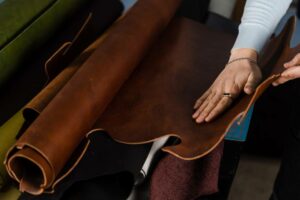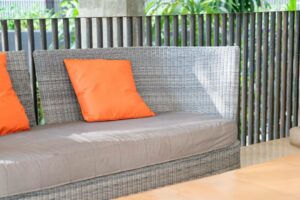Tarpaulin, often simply called tarp, is a durable, heavy-duty material known for its waterproof properties.
Manufacturers often manufacture tarpaulin from materials such as Polyester, Polyvinyl Chloride (PVC), and Polyethylene (PE). These materials are then coated or treated for water resistance, UV resistance, and tear prevention.
Main Features of Tarpaulin
Kintex supplies high-quality tarpaulin that comes with numerous beneficial features. Most notably, our tarps are eco-friendly and reusable as they are made from cotton.
Additionally, since we use natural materials to produce our tarps, there is airflow between the fibres that prevents the items underneath from rusting.
Lightweight and water-resistant, these tarps are also easy to handle yet incredibly durable. In addition, their versatility spans various industries, from household coverings to demanding industrial applications.
Varieties of Tarpaulin: Colours and Uses
Tarpaulin comes in many different colours, each with a specific use. For example:
- Blue: Blue tarps are great for general-purpose applications. They are also easily recognisable and distinguished.
- Green: Green tarps are ideal for outdoor uses where they can blend with natural surroundings. The most notable examples are military applications, camping, and gardening.
- Brown: Brown tarps also blend well with earthy or wooded environments such as camping, hunting, or outdoor events in natural settings.
- White: White tarps are perfect for applications requiring light transmission or reflection. You can use them to create well-lit outdoor spaces, temporary shelters, or cover sensitive materials needing protection from excessive heat.
- Clear/Transparent: Clear or transparent tarps are often used for applications where light transmission or visibility is crucial, such as greenhouse coverings or temporary window or door replacements.
- Camouflage: Camouflage-patterned tarps are frequently used for hunting, military operations, or outdoor activities that also require blending into the surroundings.
Applications of Tarpaulin

1. Outdoor
Tarpaulin excels in outdoor applications. They can be used as shelters or temporary structures to provide shade and protection from sun, rain, dust or wind.
They also protect goods on trucks, trailers, or flatbeds during transportation. Moreover, farmers can use tarps to cover crops, hay bales, or silage from adverse weather conditions. Lastly, nurseries and greenhouses can also use them as shade covers.
2. Indoor
Indoors, tarps can protect the floor during construction, renovations, painting, or other activities that may generate dust, debris, or spills.
They are also ideal for protecting artworks, canvases, and studio floors from spills and damage during creative processes or projects.
Caring for Your Tarpaulin
Proper cleaning and storage can significantly enhance the longevity and durability of your tarps.
1. Cleaning
To clean your tarp, shake off or brush away any loose dirt or debris using a soft brush. For specific stains or spots on the tarp, spot cleaning with a mild detergent or soap would do the trick.
Then, allow the tarps to air dry in a well-ventilated area or lay it flat on a clean surface.
2. Storage
After drying, fold it neatly to store it in a clean, dry location away from direct sunlight, moisture, and pests. It would be best to avoid storing in a tightly sealed plastic bag to prevent mould growth.
Choosing the Right Tarpaulin
Choosing and purchasing a suitable tarpaulin involves several considerations. This is to ensure the appropriate tarp is bought for the specific purpose.
Make sure to evaluate the intended use, size, and dimension to ensure you choose the right tarp for your needs. You should also consider your budget, as pricing can vary depending on the tarpaulin type.
Environmental Impact and Sustainability

1. Maintenance and Care
Proper maintenance and care of tarpaulin can help prolong its lifespan and reduce the need for frequent replacements. Regular cleaning, storage in suitable conditions, and proactive repair of minor damages can also help maximise its utility.
2. Reusability and Recyclability
It would be best if you also consider the end-of-life options for tarpaulin. Look for reusable tarps, which can serve multiple purposes and reduce waste. If the tarp is no longer usable, consider the available recycling options.
Some materials, such as polyethylene, can be recycled into new products, reducing the demand for virgin materials.
3. Responsible Disposal
Proper disposal is important when the tarpaulin reaches the end of its life. If recycling is unavailable, follow local waste management guidelines and dispose of the tarp responsibly to minimise environmental impact.
Experience the Versatility of Tarpaulin Canvas with Kintex
At Kintex, we understand the importance of quality and versatility in every product. Therefore, our tarpaulin are a testament to this commitment. We provide an array of colour options, each designed for a specific application, catering to a broad spectrum of industries and needs.
By prioritising both functionality and eco-friendliness, our tarpaulin is more than just protective coverings. They represent our dedication to serving our customers responsibly and sustainably.
So, take advantage of the robust, adaptable, and environmentally-friendly collections that Kintex offers. As Malaysia’s leading supplier of upholstery materials, we invite you to discover the potential of tarpaulin for your needs, whether they’re personal or industrial.
Join us at Kintex, and let’s explore the power of tarpaulin together, enhancing your life while protecting our planet.







